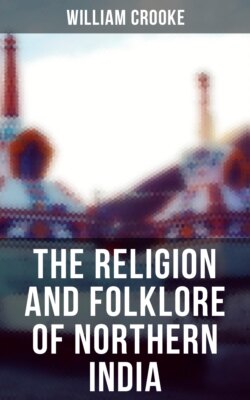Читать книгу The Religion and Folklore of Northern India - William Crooke - Страница 71
На сайте Литреса книга снята с продажи.
Mother-worship in Upper India.
ОглавлениеTable of Contents
In the Hills what is known as the Mâtrî Pûjâ is very popular. The celebrant takes a plank and cleans it with rice flour. On it he draws sixteen figures representing the Mâtrîs, and to the right of them a representation of Ganesa. Figures of the sun and moon are also delineated, and a brush made of sacred grass is dipped in cow-dung and the figures touched with it. After the recital of verses, a mixture of sugar and butter is let drop on the plank, three, five, or seven times. The celebrant then marks the forehead of the person for whose benefit the service is intended with a coin soaked in butter, and keeps the money as his fee. The service concludes with a waving of lamps to scare vicious ghosts, singing of hymns and offering of gifts to Brâhmans.59
At Khalârî, in the Râêpur District of the Central Provinces, is a Satî pillar worshipped under the name of Khalârî Mâtâ. According to the current legend Khalârî Mâtâ often assumes a female human form and goes to the adjacent fairs, carrying vegetables for sale. Whoever asks any gift from her receives it. Once a young man returning from a fair was overtaken by a strange woman on the road, who said she was going to see her sister. She asked him to go in front, and said that she would follow. Not wishing to allow a beautiful young woman to travel alone at night, he hid himself among some bushes. Presently he heard a great jingling noise and saw a four-armed woman go up the steep, bare hill and disappear. It was quite certain that this was Khalârî Mâtâ herself.60
In many parts of the plains, Mâyâ, the mother of Buddha, has been introduced into the local worship as the Gânwdevî, or village goddess. Her statues, which are very numerous in some places, are freely utilized for this purpose. In the same way a figure of the Buddha Asvaghosha is worshipped at Deoriya in the Allahâbâd District as Srinagarî Devî.61
